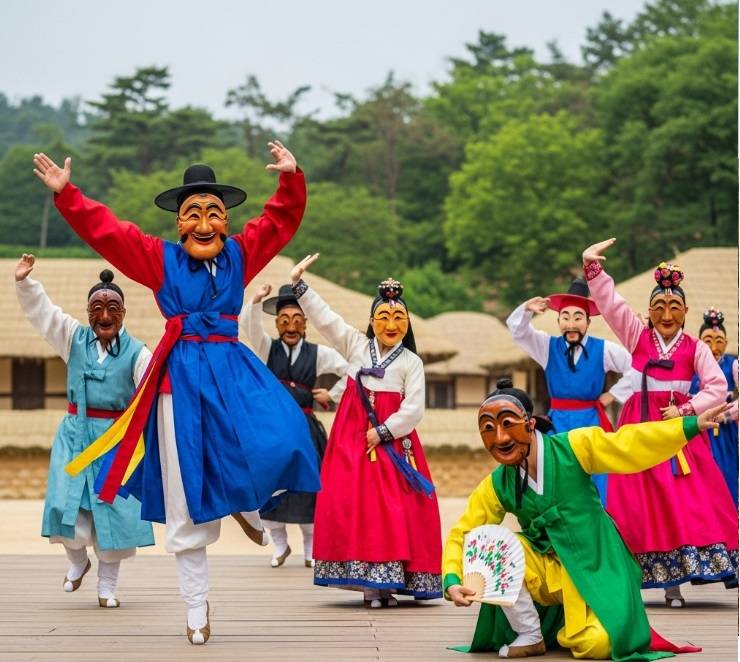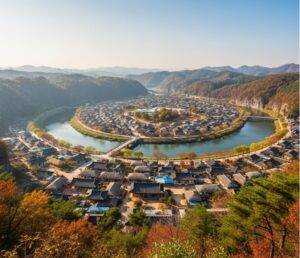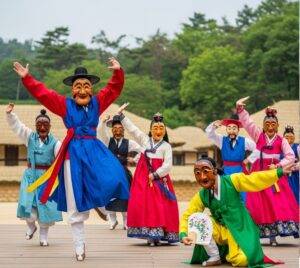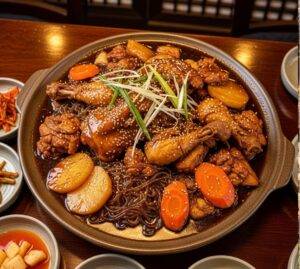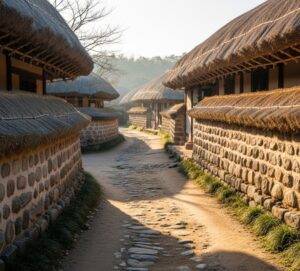I get it. You’re planning a trip to South Korea, your itinerary is getting crowded, and you keep seeing this place—Andong Hahoe Folk Village—pop up. It’s a UNESCO World Heritage site, it looks beautiful in photos, but it’s a bit of a journey from Seoul. The big question is: Is it genuinely worth your precious travel time?
As someone who’s explored countless corners of Korea, I’m here to give you my completely honest Andong Hahoe Folk Village reviews. I’ll take you beyond the postcards and tell you what it’s really like.
Urgent Hot Tip for Fall 2025 Travelers: If you’re reading this around August or September, listen up! The world-famous Andong Mask Dance Festival is happening from September 26th to October 5th, 2025. This is hands-down the best time to visit, and you’ll want to book everything ASAP. More on that below!
First, How to Get to Andong from Seoul
Let’s get the logistics out of the way first. Getting to Andong from Seoul is surprisingly straightforward, and you have two great options.
- By KTX Train (My Recommendation): This is the fastest and most comfortable way. Take the KTX train from Cheongnyangni Station in Seoul directly to Andong Station. The journey takes just over 2 hours. From Andong Station, you can easily catch a local bus (No. 210 or 219) or a taxi for the final 30-40 minute ride to Hahoe Village.
- By Express Bus: A more budget-friendly option. Buses depart from the Dong Seoul Bus Terminal and take about 3 hours to reach the Andong Bus Terminal. The buses are comfortable, but the journey is slightly longer than the train. From the bus terminal, you can also take a local bus or taxi to the village.
Pro Tip: I took the KTX and loved it. The ride was smooth, scenic, and got me to Andong feeling refreshed and ready to explore.
My Top 5 Experiences in Hahoe Folk Village (A Personal Review)
This isn’t just a place with old houses; it’s a living, breathing village where people from the Ryu clan have lived for over 600 years. Here’s what truly made my visit unforgettable.
1. Getting Lost in the Labyrinth of Thatched-Roof Houses
The first thing you must do is put away the map for a little while. Just wander. The village is shaped like a lotus flower, and its winding, unpaved alleyways are magical. Walking along the stone walls, past homes with tiled roofs (for the aristocracy) and thatched roofs (for the commoners), feels like you’ve been transported back to the Joseon Dynasty. Wear your most comfortable shoes – the village is large and the paths are all dirt!
2. Climbing Buyongdae Cliff for That Iconic View
Across the Nakdong River from the village is Buyongdae Cliff. This is non-negotiable! You take a small, traditional ferry across the river (it costs just a few thousand won) and then make a short, slightly steep 10-minute climb. The reward? The single best panoramic view of Hahoe Village. Seeing it nestled perfectly in the river bend from above gave me a true appreciation for its geography and beauty. It’s the photo everyone wants, and for good reason.
3. Laughing Out Loud at the Hahoe Mask Dance (Byeolsingut Talnori)
I’ll be honest, I wasn’t sure what to expect from a traditional mask dance. I thought it might be a bit dry. I was so wrong. The Hahoe Mask Dance is a satirical, hilarious, and engaging performance that pokes fun at the rigid social classes of the past. Even without understanding every word, the characters’ movements and the audience’s reactions are universal. I was genuinely laughing out loud. The performance is free with your entrance ticket, but get there 20 minutes early to grab a good seat in the shade.
4. Walking the Mansongjeong Pine Forest
This beautiful pine forest was planted by the Ryu clan centuries ago to protect the village from the winter winds. Today, it’s an incredibly serene place for a walk. It offers a stunning view back at Buyongdae Cliff and is the perfect spot to cool down on a hot day. I loved the contrast between the bustling village center and the peaceful quiet of the forest.
5. Finding the 600-Year-Old Zelkova Tree
At the heart of the village stands the Samsindang, a massive Zelkova tree that is believed to house the village’s guardian goddess. The tree is adorned with hundreds of white paper wishes tied to its surrounding ropes. It’s a powerful and spiritual spot. Taking a moment to read some of the wishes and add my own was a surprisingly moving experience that connected me to the village’s living traditions.
Hot Tip: The 2025 Andong Mask Dance Festival Schedule
This is one of Korea’s most vibrant and important festivals. If your trip aligns, you HAVE to go.
- When: Friday, September 26th to Sunday, October 5th, 2025.
- Where: The main festival grounds are in downtown Andong, with special performances still held at Hahoe Folk Village.
- What to Expect: An explosion of culture! You’ll see traditional mask dance performances from all over Korea and the world, parades, hands-on activities, and an incredible selection of street food.
- My Advice: This is a huge event. Book your accommodation and KTX tickets now. Seriously, they will sell out. Check the official festival website for the detailed daily Andong mask dance festival schedule so you can plan which performances to see.
What to Eat in Andong (It’s More Than Just Jjimdak!)
When people talk about Andong food, one dish dominates the conversation: Andong Jjimdak. But there’s more to explore!
The Quest for the Andong Jjimdak Original Restaurant
Andong Jjimdak is a savory and slightly spicy braised chicken dish with vegetables and glass noodles. It’s pure comfort food. The best place to try it is in Andong’s Jjimdak Golmok (Jjimdak Alley) in the city’s market. You’ll find dozens of restaurants all claiming to be the best.
My strategy? I just walked down the alley and picked the one that was busiest with locals. You can’t go wrong. The portions are huge, so a small size is usually enough for two or three people. It was one of the most satisfying meals I had in Korea.
Don’t Miss These Other Andong Delicacies:
- Heotjesabap: Often called “fake ceremonial food,” this is a bibimbap-style dish that aristocrats would eat when they craved ceremonial food on a regular day. It’s served with soy sauce instead of gochujang and is a lighter, more savory experience.
- Godeungeo (Salted Mackerel): Andong is landlocked, but it became famous for its salted mackerel during the Joseon Dynasty because it was the farthest fish could travel from the coast before going bad. It’s expertly salted and grilled to perfection.
Is Staying Overnight in Hahoe Village Worth It?
This is a fantastic question. You can stay in a hanok (traditional Korean house) or minbak (a room in a family home) right inside the village.
The Pros:
- Atmosphere: It’s absolutely magical. Once the day-trippers leave, the village becomes incredibly peaceful and quiet. Waking up to the morning mist over the thatched roofs is an experience you’ll never forget.
- Authenticity: You get a small glimpse into traditional Korean life. Sleeping on a yo (mattress) on the ondol (heated) floor is a core cultural experience.
- Early Access: You can explore the village at sunrise before anyone else arrives.
The Cons:
- Basic Amenities: Don’t expect hotel luxuries. Bathrooms are often shared, and the walls can be paper-thin.
- Limited Food Options: Most restaurants close early, so you’ll likely eat wherever you’re staying.
- Logistics: Dragging your luggage over dirt paths can be a hassle.
My Verdict: If you’re an adventurous traveler who values atmosphere over comfort, 100% yes, do it for one night. If you prefer modern comforts, stay in a hotel in Andong city and visit the village as a day trip.
- Ready for an authentic experience? 👉 Explore traditional stays inside Hahoe Village on Booking.com
- Prefer a modern hotel? 👉 Find top-rated hotels in nearby Andong city here.
The Final Verdict: My Honest Andong Hahoe Folk Village Review
So, is it worth the trip?
YES, it’s an absolute must-visit for:
- Culture & History Lovers: This is one of the best-preserved examples of Joseon-era clan life in the entire country. It’s living history.
- Photographers: The scenery, from the traditional architecture to the view from Buyongdae Cliff, is breathtaking.
- Travelers Seeking Authenticity: This isn’t a rebuilt tourist trap. It’s a real, functioning village that offers a genuine look into Korea’s past and present.
You might want to skip it if:
- You’re on a very tight schedule: While you can do it as a long day trip from Seoul, it’s best experienced with at least one night in Andong to avoid feeling rushed.
- You prefer fast-paced cities: Hahoe Village is the definition of slow travel. Its charm is in its peace and quiet.
For me, the journey was more than worth it. It was a chance to disconnect from the frantic energy of Seoul and connect with a deeper, more traditional side of Korea. My visit provided some of the most lasting memories of my time here, and my final Andong Hahoe Folk Village reviews are overwhelmingly positive.
Frequently Asked Questions (FAQ)
How much time do you need to see Hahoe Folk Village properly?
I recommend at least 4-5 hours. This gives you enough time to walk through the village, see the mask dance performance (which is about 1 hour long), and climb Buyongdae Cliff without rushing.
What is the entrance fee for the village?
As of late 2025, the entrance fee for adults is ₩5,000. Prices can change, so it’s always good to check the official Hahoe Village website before your visit.
Are there still people living in Hahoe Folk Village?
Yes! This is what makes the village so special. It is a living community, and descendants of the original Ryu clan still reside here. Be respectful and remember you are walking through their neighborhood.
Can I visit Andong as a day trip from Seoul?
Yes, it is possible, but it will be a very long and tiring day. You would need to take the first KTX train out of Seoul and the last one back. To truly enjoy the experience and not feel rushed, I highly recommend staying overnight either in the village or in Andong city.
Hi, I’m [jeybee]. As a long-time resident of Seoul, I’m passionate about uncovering the authentic, everyday magic of Korea. This blog is my way of sharing my favorite spots, tips, and cultural insights with you, beyond the usual tourist traps.

